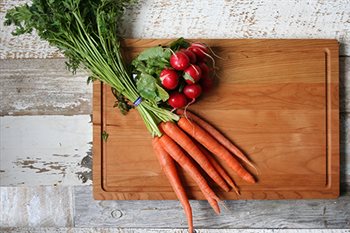
When raw foods are prepared without the proper precautions, harmful bacteria can be transferred to your food. This results in contamination which, after consumption, may lead to foodborne illnesses. This is especially true when you’re working with raw meat. Let’s look at the steps that must be integrated into your butcher block care routine in order to prevent this from happening.
It is important that you start with and maintain a sanitized butcher block. The first step in this process is thoroughly washing the board after each use. There are a variety of natural ways to ensure that you kill harmful bacteria, including vinegar or salt and lemon mixtures. Click here for a complete list of these practices. Be mindful that a butcher block cannot be submerged in water and therefore will not survive a round in the dishwasher. However, scrubbing the butcher block with your favorite combination of natural products and drying with a clean towel is an effective way of sanitizing.
Your butcher block may be sanitized but if you put a contaminated vegetable on the cutting board, this could transfer the bacteria to the surface. Although cooking the food will eliminate bacteria you eat, you may not always cook after cutting your fruits and vegetables. Preparing vegetables for a salad is a good example of this. In order to eliminate the risk completely, you should always rinse your raw produce before letting it get anywhere near your butcher block.
Raw fish and meats are notorious for their potential to contaminate your butcher block with harmful bacteria. This problem can become worse if you cut one type of protein and switch to another type right after. You should never allow one protein to come into contact with another. One way to avoid this is to have multiple hardwood butcher block boards that serve unique purposes. You could have one board for poultry, another for seafood and yet another for red meats. We have multiple sizes in our selection of butcher block boards and offer three species of wood, which could help you color code and keep each board unique to a certain ingredient.
When your butcher block has cracks or too many deep scratches, harmful bacteria will find its way into these areas and be left untouched by your sanitization routine. Maintaining the integrity of the surface of your board is key to avoiding this. Two factors will come into play here. One is that you must keep your board oiled regularly. This will seal in humidity and keep dryness out. Remember that if your butcher block is kept in either a too dry or too humid environment, you are increasing the risk of warping and cracking. The other factor is sanding the surface of the board when scratches become too evident. This will restore the flat surface needed in order to ensure proper sanitization.
Remember that by sanitizing your board, washing your vegetables, using different boards and oiling regularly will altogether ensure that your butcher block is free from harmful bacteria, making it completely safe to use. Discover our selection of beautiful butcher blocks today!